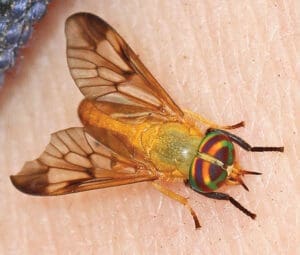By Cindy Mulla, Beach Mosquito Control District
Northwest Florida is known for its beautiful topography, weather and bright sunny skies which offer year-round outdoor enjoyment for both residents and visitors until the perfect swarm arrives to take a bite out of your outdoor recreational fun or projects.
Yellow Flies:
 The insect commonly referred to as the “yellow fly” emerges as a fierce biting adult as early as March, with peaking population numbers during the months of May through June and sometimes present through October. Their common name is due to the yellow color of their abdomen. These flies are active throughout the day. Depending on the Yellow Fly species, their peak activity time will vary from morning hours through the late afternoon. The adults prefer habitats with shady areas over bright, sunny locations. Their favorite natural places include along the outer border of woodland areas, ponds, springs, swamps, creeks, or rivers. On cloudy days they tend to be more adventurous, leaving their natural habitats and encroaching upon your homefront. They are found near pools, under overhangs of buildings or inside garages. They are aggressive, vicious biters, and are known to chase and follow people into their cars or place of shelter.
The insect commonly referred to as the “yellow fly” emerges as a fierce biting adult as early as March, with peaking population numbers during the months of May through June and sometimes present through October. Their common name is due to the yellow color of their abdomen. These flies are active throughout the day. Depending on the Yellow Fly species, their peak activity time will vary from morning hours through the late afternoon. The adults prefer habitats with shady areas over bright, sunny locations. Their favorite natural places include along the outer border of woodland areas, ponds, springs, swamps, creeks, or rivers. On cloudy days they tend to be more adventurous, leaving their natural habitats and encroaching upon your homefront. They are found near pools, under overhangs of buildings or inside garages. They are aggressive, vicious biters, and are known to chase and follow people into their cars or place of shelter.
Methods of personal protection include avoiding their habitats, especially during their peak season, and wearing special long-sleeved outdoor protective clothing and repellents. Prior to purchasing the repellent, read the label to see what insects it will repel. Before applying a repellent, read and follow the label instructions and reapply as recommended by the manufacturer. If you have any prior medical concerns about using a repellent, consult your medical physician first.
It is exceedingly difficult to mechanically or chemically control Yellow Fly populations because their life cycle begins in aquatic natural wetland areas where treatment is not an option. Adulticides are not effective as they are with mosquitoes.
“No-See-Ums!!!”
These biting midges are commonly known as punkies, or sandflies. They are very stealthy and annoying because when you look to see what just bit you there is nothing there except for the inflicted bite site on your body. Another common name for this pest is “flying teeth” due to the way they feed with their long sharp scissor-like mandibles making a small cut into their victim’s skin. They also prefer warm weather and begin to appear in large numbers in the spring. Biting midges are located along Florida’s coastal region, swamps, and salt marshes. Depending on the region of Florida you reside in or the area you are visiting, these bloodthirsty insects can be a pest during the late fall and winter months. Unseasonable warmer winter temperatures can prolong their activity.
Unlike the yellow fly, they prefer to bite during dusk and dawn hours just like mosquitoes and are sometimes mistaken for being a mosquito problem. They may also be of annoyance on calm overcast days or windless nights. Unfortunately, due to the extensive area to control biting midges plus their complete metamorphosis life cycle that occurs in the natural wetland breeding locations in Florida, treatment is impossible. Temperatures above 90 degrees normally will inhibit the biting midge problem.
Recommended biting midge prevention includes avoiding the outdoors during peak biting times, wearing repellents labeled for biting midges, using specific gage screen materials specific to keep these pests away or using high velocity fans to increase airflow on porches or patios.
However, mosquitoes are still number one due to their public health concern of having the potential to spread harmful or deadly mosquito-borne diseases.
Mosquitoes are the world’s deadliest creatures. Accordingly, please do not hesitate to contact Beach Mosquito Control District to place your service request for all your mosquito concerns. Beach Mosquito Control District Contact Information: (850) 233-5030 or www.pcbeachmosquito.org.
We base our science-based mosquito control methods and treatments on the number and location of service requests we receive from the public and our mosquito surveillance program. This service is made possible through levying local ad-valorum tax with no additional cost to you. So do not wait, contact us today!





















































